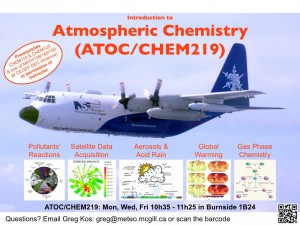I have successfully completed my Winter term teaching. I taught two courses, the Atmosphere and Ocean Lab at McGill University and the Chromatography Lab at Bishop’s University. I also supervised an Honour’s student at Bishop’s University, who graduated at the beginning of June (Congratulations, Kaylee!).
Now it is time to focus on my research projects again. I continue collaborating on the Mycospec project, where I develop chemometric models from mid-infrared data in Matlab. With model development and validation complete for the current data sets — a bagged decision tree algorithm turned out to be the best choice, I provide support for software development, while waiting for new infrared data to come in.
I also started a new, exciting project, looking at air pollutant concentrations (especially ozone) in major Canadian cities in the last 10 years. After initial statistical analysis, I have started a modelling exercise using the CAABA/MECCA box model to better understand the mechanisms responsible for certain observed pollution scenarios. This is shaping up to be very interesting.
